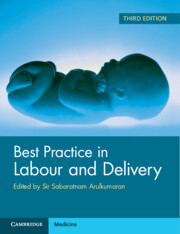Book contents
- Best Practice in Labour and Delivery
- Reviews
- Best Practice in Labour and Delivery
- Copyright page
- Contents
- Contributors
- Preface to the Third Edition
- Acknowledgements
- Chapter 1 Pelvic and Fetal Cranial Anatomy and the Stages and Mechanism of Labour
- Chapter 2 The First Stage of Labour
- Chapter 3 Analgesia and Anaesthesia in Labour and Delivery
- Chapter 4 Intrapartum Fetal Monitoring
- Chapter 5 Uterine Contractions
- Chapter 6 Identification and Management of Presumed Intrapartum Fetal Distress
- Chapter 7 Prolonged Second Stage of Labour Including Difficult Decision-Making on Assisted Vaginal Birth and Caesarean Birth
- Chapter 8 Instrumental Vaginal Deliveries
- Chapter 9 Vaginal Breech Deliveries and External Cephalic Version
- Chapter 10 The Evidence-Based Caesarean Delivery Technique
- Chapter 11 Shoulder Dystocia
- Chapter 12 Umbilical Cord Prolapse
- Chapter 13 Twin Delivery
- Chapter 14 Antepartum Haemorrhage
- Chapter 15 Management of the Third Stage of Labour
- Chapter 16 Postpartum Haemorrhage
- Chapter 17 Management of Placenta Accreta Spectrum
- Chapter 18 Acute Illness and Maternal Collapse
- Chapter 19 Episiotomy and Obstetric Perineal Trauma
- Chapter 20 Induction of Labour
- Chapter 21 Preterm Pre-labour Rupture of Membranes
- Chapter 22 Preterm Birth
- Chapter 23 Labour in Women with Medical Disorders
- Chapter 24 Management of Women with Previous Caesarean Section
- Chapter 25 Hypertensive Disorders in Labour and Delivery
- Chapter 26 Rupture of the Uterus
- Chapter 27 Neonatal Resuscitation and the Management of Immediate Neonatal Problems
- Chapter 28 The Immediate Puerperium
- Chapter 29 Triage and Prioritisation on Labour Wards
- Chapter 30 Maternity Training in the Twenty-First Century
- Chapter 31 Risk Management in Intrapartum Care
- Chapter 32 Cerebral Palsy Arising from Events in Labour
- Chapter 33 Non-technical Skills to Improve Obstetric Practice
- Index
- References
Chapter 26 - Rupture of the Uterus
Published online by Cambridge University Press: 16 October 2025
- Best Practice in Labour and Delivery
- Reviews
- Best Practice in Labour and Delivery
- Copyright page
- Contents
- Contributors
- Preface to the Third Edition
- Acknowledgements
- Chapter 1 Pelvic and Fetal Cranial Anatomy and the Stages and Mechanism of Labour
- Chapter 2 The First Stage of Labour
- Chapter 3 Analgesia and Anaesthesia in Labour and Delivery
- Chapter 4 Intrapartum Fetal Monitoring
- Chapter 5 Uterine Contractions
- Chapter 6 Identification and Management of Presumed Intrapartum Fetal Distress
- Chapter 7 Prolonged Second Stage of Labour Including Difficult Decision-Making on Assisted Vaginal Birth and Caesarean Birth
- Chapter 8 Instrumental Vaginal Deliveries
- Chapter 9 Vaginal Breech Deliveries and External Cephalic Version
- Chapter 10 The Evidence-Based Caesarean Delivery Technique
- Chapter 11 Shoulder Dystocia
- Chapter 12 Umbilical Cord Prolapse
- Chapter 13 Twin Delivery
- Chapter 14 Antepartum Haemorrhage
- Chapter 15 Management of the Third Stage of Labour
- Chapter 16 Postpartum Haemorrhage
- Chapter 17 Management of Placenta Accreta Spectrum
- Chapter 18 Acute Illness and Maternal Collapse
- Chapter 19 Episiotomy and Obstetric Perineal Trauma
- Chapter 20 Induction of Labour
- Chapter 21 Preterm Pre-labour Rupture of Membranes
- Chapter 22 Preterm Birth
- Chapter 23 Labour in Women with Medical Disorders
- Chapter 24 Management of Women with Previous Caesarean Section
- Chapter 25 Hypertensive Disorders in Labour and Delivery
- Chapter 26 Rupture of the Uterus
- Chapter 27 Neonatal Resuscitation and the Management of Immediate Neonatal Problems
- Chapter 28 The Immediate Puerperium
- Chapter 29 Triage and Prioritisation on Labour Wards
- Chapter 30 Maternity Training in the Twenty-First Century
- Chapter 31 Risk Management in Intrapartum Care
- Chapter 32 Cerebral Palsy Arising from Events in Labour
- Chapter 33 Non-technical Skills to Improve Obstetric Practice
- Index
- References
Summary
Peripartum rupture of the uterus is rare, but is a life-threatening complication leading to maternal and perinatal morbidity and mortality. There is wide variation in the reported incidence of rupture of the uterus, with high incidence and more morbidity and mortality among the developing countries compared to the developed world. In the high-income countries uterine rupture is mainly due to scar rupture, while in the developing world, rupture due to prolonged and obstructed labour is still happening in spite of the progress made in the field of antenatal and intrapartum care. Caesarean section rates are increasing all over the world, and women with prior caesarean section are at higher risk of uterine rupture during subsequent pregnancy. Women with a previous lower segment caesarean section can opt for an elective caesarean delivery or a vaginal delivery after caesarean (VBAC). The most feared complication of VBAC is uterine rupture with its associated maternal and fetal consequences.
Information
- Type
- Chapter
- Information
- Best Practice in Labour and Delivery , pp. 331 - 342Publisher: Cambridge University PressPrint publication year: 2025
